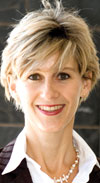

There are some people who will do whatever it takes, no matter the odds, for a cause. Steve Fitzpatrick is one of them.
Steve Fitzpatrick and his partner Peter Keshwar are the brains behind the Healthcare Management System called iNathi SysCare. It is an electronic healthcare solution aimed at changing the dynamics of healthcare in the rural clinics of South Africa. They are certain that their system is the answer to South African clinics’ overloaded healthcare workers, catastrophic patient management and unnecessary fatalities.
Fitzpatrick’s journey began five years ago while working on a business development plan for healthcare systems in rural communities. “The state of patient management in South African clinics was in dire need of attention,” explains Fitzpatrick, who had been tasked to address the situation by coming up with a technology-based solution to address the crisis. “It became apparent, after several attempts at proposing internationally accepted IT management systems to these clinics, that these solutions were just not suitable. They simply did not synchronise with the needs of the clinics.”
The role of the health worker in designing the SysCare system was huge, Fitzpatrick explains. “After telling us that we were simply not listening to them; that we needed to understand the basic daily routines of their clinics, we took the decision to visit the clinics to see how the healthcare workers operated.”
It was a decision that would change the way in which the iNathi team worked thereafter. Fitzpatrick says, “I was shocked not only at the queues, but at the terrible disarray of paperwork, filing, management and record-keeping. Half the reason for the horrendous queues spanning way beyond the entrance of the building was due to overloaded systems from within, lost records, endless searching for paperwork and as a result, overloaded nurses.”

How could such a dire situation be addressed?
“We realised then that there was no point in us sitting in our ivory towers in Johannesburg designing state-of-the-art software systems for clinics we knew nothing about. So we went back to the drawing board, aware that we could not produce an effective system for primary healthcare clinics if we were not in touch or in tune with our market.”
It was clear that the core challenges faced daily in primary healthcare clinics are patient administration, treatment management, clinic hopping and drug fraud. By introducing an affordable and appropriate technology such as iNathi SysCare, all these problems could be eliminated.
Key problems in primary healthcare
Working side-by-side with health workers and using the paper-based forms they use in their daily work as a base, iNathi created an electronic system that is not only familiar and understandable to those at the front lines of healthcare, but one that can generate the accurate reports and statistics required by decision makers. “Our system had to be based on what was already working in the clinics,” says Fitzpatrick.
The iNathi team solicited the skills of young technicians, unbiased and fresh out of university, to develop the SysCare system – a system that incorporates the enrolment of patient fingerprints for identification and verification, a user-friendly interface, queuing management and dashboard-guided consultations, as well as a flexible stock system. The system has to take into account the low computer literacy levels of health workers in these areas, incorporating pre-defined fields to eliminate errors. It needs to be flexible, mobile and run off a network or standalone database. In the end, it has to ensure that from the time a patient enters a clinic to the time that he or she leaves; the patient must be taken care of and fully documented in the system.
How it works
The healthcare worker captures all the patient’s information including their fingerprints, which are captured on the small biometric device. After a consultation, the machine will give a printout for the patient to keep and use for their medicine dispensary, etc.
Capturing these fingerprints was simple and the communities bought into it willingly. “The beauty of fingerprint technology,” says Fitzpatrick, “is it allows the patient to go to any clinic, knowing that that clinic will be able to recall his or her information instantly and digitally.”
Because the system enables a patient’s entire records to be displayed at the push of a button, nurses can quickly direct their patient to the right queue for their needs. “Queues are diminishing and people are being seen,” Fitzpatrick enthuses. “And nurses are also less stressed and more amenable to their patients.”
Another important factor is information security. “The system is secure and comes with a good backup system,” Fitzpatrick ensures. “It will never go down because we connect it to a server in the clinic. We then synchronise it to the centre server. If a single server collapses the information will automatically go to other clinics.”
Funding and partners
Whilst iNathi has acquired a number of key partners along the way, both Fitzpatrick and Keshwar have basically funded and pioneered the SysCare solution single-handedly. “It is a calling,” says Fitzpatrick, whose passion for the project runs deep. “I believe in the product passionately and I have seen the results. I know it will change the lives of millions of individuals in these communities.”
But the obstacles still rear their ugly heads. With no buy-in as yet from government, iNathi is working extremely hard to try to find avenues and a means of getting the concept into the right channels. “There is so much red-tape,” he says warily, “yet there are over 70% of the population that are using public healthcare and waiting for a better service. We have done all the necessary accreditation, compliances including SITA (RFB609/2007) accreditation. We have gone through all the legalities, yet still we fight to get through the right doors. We just have to keep pushing, because we know it will change the face of rural healthcare, and save lives. It is just a matter of when.”
To date iNathi’s key partners include:
* West Rand District Municipality.
* Sagem Security South Africa.
* SAP Research.
* University of Witwatersand.
* Mpumulanga Provincial Government.
With key business partners such as Sagem, “who saw the potential and believed in us”, iNathi was able to get the relevant biometrics training including the biometrics device to work with SysCare.
Who is implementing the system?
September 2008 saw the first implementation of iNathi SysCare in the West Rand District. The M L Pessen Clinic in Randfontein, began the transformation to electronic health records for their patients. Prior to the implementation, the only computers in the clinic were the computers used to compile and generate the clinic statistics. iNathi SysCare would see the entire clinic become integrated, from reception to health worker rooms, to stock rooms and management.
To prepare them for their new system, health workers were given basic computer literacy training, followed by SysCare-specific training. From knowing little about computer technology, the clinic transformed quickly and responsively. Within two weeks they were ready to go live, leaving the SysCare team to take their system to the next clinic.
Westonaria was the second clinic to be implemented with the system, followed four weeks later by Mogale City Central Clinic, each clinic providing its own challenges in terms of logistics and training.
The most recent clinic to be implemented is The Bekkersdal East Clinic. There, SysCare’s trainers had the privilege of meeting Sisters Margaret Ngqwebo and Mathapelo Molefe who at 75 and 68 years of age respectively, became the systems oldest users – each having never used a computer before.
Bushbuck Ridge is another area where iNathi has rolled out its system and according to Fitzpatrick, it is another success story.
The benefits were immediately tangible. Administration and queues were moving fast. To date, there are over 48 000 patient records in the West Rand system, and over 7200 in the Bushbuck Ridge area. Information is being shared, and patients are finding they are no longer recurring strangers, but individuals who matter.
A key benefit of the system is its ability to stop fraud and clinic hopping. “There are too many people abusing the allocation of drugs, but now, thanks to SysCare, records of who last picked up the drug, when and where, can be tabled. This stops people from acquiring drugs for resale or for use by other people,” says Fitzpatrick.
Another benefit is the speed with which these systems can be installed and initiated into a clinic. “We can roll out a system within a month with training,” boasts Fitzpatrick. “And our system deals with the whole suite of healthcare records. We have trained 84 people to date to use the SysCare system. By doing so, not only are we helping the healthcare system, we are actually uplifting and empowering the communities.”
Perhaps most important to these rural clinics, is the issue of cost. “The system is affordable,” stresses Fitzpatrick, “because it is simple.” An average clinic, he says, needs between 10 to 15 computers, each with a fingerprint monitor.
The future
At the moment SysCare has been introduced to Mpumulanga Gauteng and KwaZulu-Natal. Fitzpatrick says the company is currently in discussion with private companies, government organisations and NGOs to help speed up the process of implementing it into communities.
New modules will also bring additional coverage – mobile biometrics terminals will soon allow emergency management services, chronic and home visit allowing workers to have access to patient information to enable proper healthcare. This technology will ensure that a patient who cannot speak will be able to be treated correctly, as his/her fingerprint will access lifesaving information.
But despite the endless possibilities, Fitzpatrick maintains that the grass-root healthcare system is iNathi’s core focus. “We are not focusing on introducing our system to private healthcare yet, because it is the poor communities that need assistance the most.
The multiple benefits of SysCare
* One patient view across boundaries.
* SMS facility to eradicate visit date confusion.
* Accurate patient file data.
* Accurate treatment history.
* Accountability of stock and the usage thereof.
* Audit trails of health workers.
* Improved service delivery.
* Due to the automation of reporting, the clinics are now able to open for longer hence providing healthcare to more patients.
* The queuing facility allows the health worker to distinguish against the more critical patients for faster treatment.
* The biometrics allows for accurate patient identification.
* All processes are available in the form of a report.
* Lab results can now be stored together with the patients details without being lost.
* Drug tracking for HIV and TB.
* Comprehensive HIV/Aids module in line with governments' HIV/Aids programme.
* Designed in conjunction with the health workers so that they could identify with all relevant processes and procedures.
* Complaints system for both health worker and the patient.
* Patient record is stored in high security environment for extreme patient confidentiality.
* Eliminates excessive time lost in data capturing.
* Accurate data.
* iNathi SysCare can integrate perfectly with smartcards, barcode and SMS technology.
Problems to overcome
iNathi identified the following critical problems faced by clinics – all of which needed to be addressed and alleviated via a simple technology solution:
* Service delivery and quality.
* Patient duplication.
* Drug fraud and clinic hopping.
* Patient record: confidentiality, security and storage.
* Patient history: completion, accuracy and access.
* Treatment monitoring, PHC guideline access and awareness.
* Patient management.
* Statistics and planning.
With these key problems in mind, iNathi developed a patient record system with the goal of enhancing healthcare by lessening the workload of health workers. It ensured completeness and accuracy of patient records across various clinics, as an automated, mobile, expandable Primary Healthcare (PHC) Clinic Management System.

© Technews Publishing (Pty) Ltd. | All Rights Reserved.